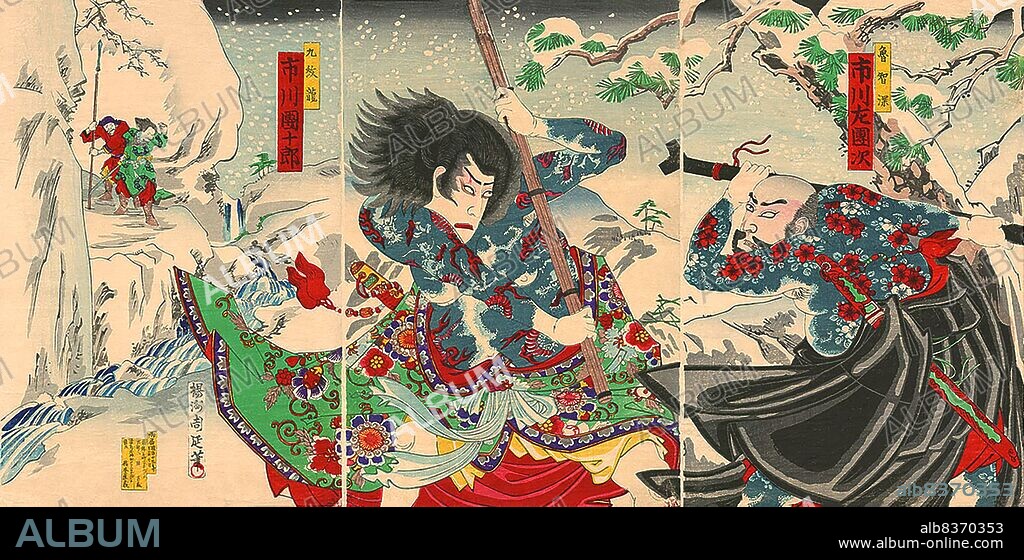alb8370353
Japan: Meiji Period woodblock triptych depicting a fight between Rochishin and Kyumonryo in a Kabuki stage play, by Toyohara Chikanobu (1838-1912),1886

|
Ajouter à une autre Lightbox |
|
Ajouter à une autre Lightbox |



Avez-vous déjà un compte? S'identifier
Vous n'avez pas de compte ? S'inscrire
Acheter cette image.
Sélectionnez l'usage:

Titre:
Japan: Meiji Period woodblock triptych depicting a fight between Rochishin and Kyumonryo in a Kabuki stage play, by Toyohara Chikanobu (1838-1912),1886
Légende:
Voir la traduction automatique
Toyohara Chikanobu, better known to his contemporaries as Ysh Chikanobu, was a prolific woodblock artist of Japan's Meiji period. His works capture the transition from the age of the samurai to Meiji modernity.
. In 1875 (Meiji 8), he decided to try to make a living as an artist. He travelled to Tokyo. He found work as an artist for the Kaishin Shimbun. In addition, he produced nishiki-e artworks. In his younger days, he had studied the Kan school of painting; but his interest was drawn to ukiyo-e.
. Like many ukiyo-e artists, Chikanobu turned his attention towards a great variety of subjects. His work ranged from Japanese mythology to depictions of the battlefields of his lifetime to women's fashions. As well as a number of the other artists of this period, he too portrayed kabuki actors in character, and is well-known for his impressions of the mie (formal pose) of kabuki productions.
. Chikanobu was known as a master of bijinga, images of beautiful women, and for illustrating changes in women's fashion, including both traditional and Western clothing. His work illustrated the changes in coiffures and make-up across time. For example, in Chikanobu's images in Mirror of Ages (1897), the hair styles of the Tenmei era, 1781-1789 are distinguished from those of the Keio era, 1865-1867.
. In 1875 (Meiji 8), he decided to try to make a living as an artist. He travelled to Tokyo. He found work as an artist for the Kaishin Shimbun. In addition, he produced nishiki-e artworks. In his younger days, he had studied the Kan school of painting; but his interest was drawn to ukiyo-e.
. Like many ukiyo-e artists, Chikanobu turned his attention towards a great variety of subjects. His work ranged from Japanese mythology to depictions of the battlefields of his lifetime to women's fashions. As well as a number of the other artists of this period, he too portrayed kabuki actors in character, and is well-known for his impressions of the mie (formal pose) of kabuki productions.
. Chikanobu was known as a master of bijinga, images of beautiful women, and for illustrating changes in women's fashion, including both traditional and Western clothing. His work illustrated the changes in coiffures and make-up across time. For example, in Chikanobu's images in Mirror of Ages (1897), the hair styles of the Tenmei era, 1781-1789 are distinguished from those of the Keio era, 1865-1867.
Crédit:
Album / Universal Images Group / Pictures From History
Autorisations:
Modèle: Non - Propriété: Non
Questions sur les droits?
Questions sur les droits?
Taille de l'image:
5100 x 2527 px | 36.9 MB
Taille d'impression:
43.2 x 21.4 cm | 17.0 x 8.4 in (300 dpi)
Mots clés:
ART (CATÉGORIE) • ART • ASIE • ASIE, CONTINENT • BAL • CONTINENT ASIE • DANCEUR • DANSE • JAPON • JAPONAIS • JAPONAISE • KABUKI • ORNEMENT, JAPONAIS • PEINTURE TRYPTIQUES • PERFORMEUR • PERFORMEUSE • PLATEFORME • TRIPTYQUE • TRIPTYQUES
 Pinterest
Pinterest Twitter
Twitter Facebook
Facebook Copier le lien
Copier le lien Email
Email
